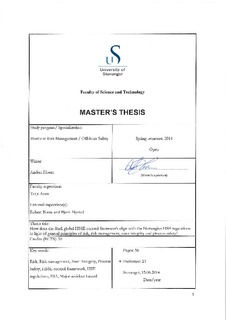| dc.description.abstract | The Norwegian regulatory and supervisory system is performance based and designed so that the operating companies hold total responsibility for operating in an acceptable manner. The Petroleum Safety Authority (PSA) will often recommend certain practices or ways to solve certain problems, but will not force preferred solutions on the companies. Instead, operators on the Norwegian continental shelf are expected to evaluate, identify and demonstrate the best suitable solutions to a problem. It is thereby the operators own responsibility to demonstrate compliance with the laws and regulations.
Royal Dutch Shell has been operating with an exploration and production department on the Norwegian continental shelf since the mid 1960s. Shell currently operates eight licenses on the Norwegian continental shelf, including the Draugen field and the Ormen Lange gas field, and is partner in an additional 17 licenses.
Through the Norwegian HSE regulations, the Norwegian authorities require that all operators “establish, follow up and further develop a management system designed to ensure compliance with requirements in the health, safety and environment legislation” (PSA 2011a). In Royal Dutch Shell, this is ensured through the application of the group HSSE&SP Control framework.
This thesis provides a comparison and discussion on selected key elements of the Norwegian HSE regulations and the Shell HSSE&SP control framework with a focus on risk, risk management, asset integrity and process safety management. The thesis identifies a total of five areas with potential gaps, and suggests four concrete recommended actions to address these findings. Identified areas include elements of barrier management, general risk theory and principles for risk reduction.
The Shell HSSE&SP control framework is designed as a standardized tool for use in all parts of the Shell group. The fact that Shell is a global company operating in many different countries, with different regulatory regimes has been taken into consideration when recommending actions for ensuring compliance with the Norwegian regulations. | nb_NO |

